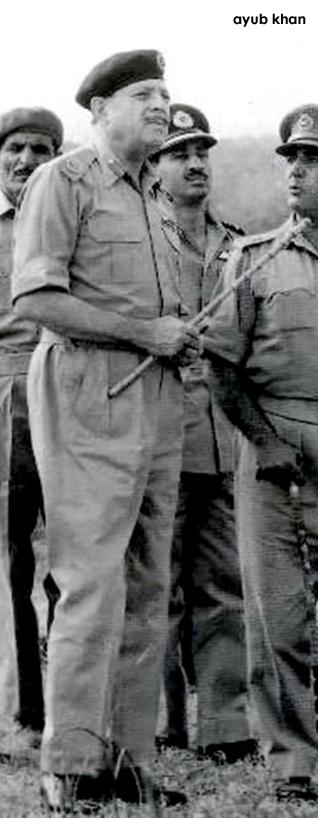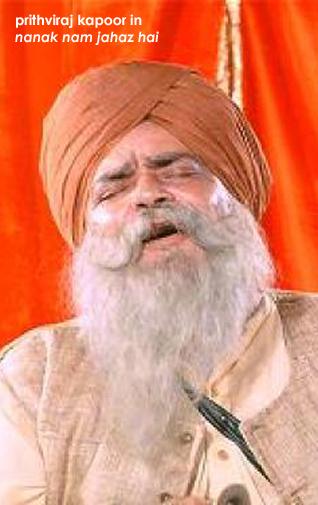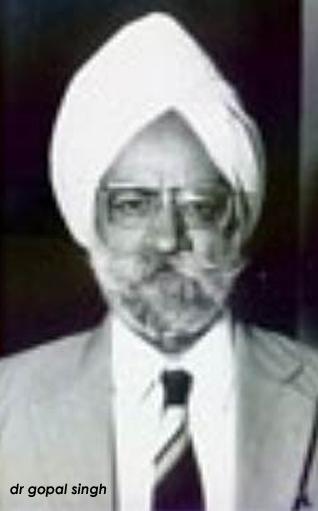Partition
Movers & Shakers of Haripur
Tales of Haripur, Part V
Dr. Bhai HARBANS LAL
Haripur Hazara has had its fair share of prominent people.
The most outstanding from among the Muslims was General Ayub Khan who rose to the position of the President of Pakistan, after serving as the country's Chief of Army Staff and the Field Marshall.
His son Gohar Ayub Khan served as the Speaker of Pakistan’s National Assembly and also as the nation's Foreign Minister.
It is perhaps because of the influence of his schooling at a Sikh school and his closeness with Sikh schoolmates that caused
Ayub Khan to have a soft corner in his heart for the Sikhs. A paragraph from his 1967 autobiography, “Friends Not Masters”, is worth quoting. He wrote:
"The school was run by Sikhs and the teachers were very kindly and considerate, except for master Sujhan Singh who was a Tartar ... Sikhs were large-hearted people. I found their rituals and their songs in Punjabi absorbing. I still remember a line which fascinated me at that time”.
'Sau rang tamashe takai, akhian nahin rajian'
Ayub translated this line as: "Life is a great spectacle of colors; one sees so much of it and yet one has an insatiable desire for
more."
Bhai Meharban Singh, a famous personality of Singapore, once described his visit with General Ayub Khan in the 1970's. Ayub Khan invited him for dinner at his home in Pakistan’s capital. When visiting his home, Meharban Singh saw a framed painting of the opening verse the Guru Granth Sahib - the Mool Mantar - on the wall. It was written both in Urdu and in Punjabi. On further inquiry, Ayub Khan is said to explained that he had a great regard for Baba Nanak and his hymns. He remembered how he had often recited that verse with his Sikh friends in Sshool.
My family had closeties with the Ayub Khan’s family. Although I visited his home several times, I do not remember too many details. He was several years older than me, so I felt somewhat intimidated. Even then, he was a lot of fun. I clearly recall that my mother often visited their home to see his female relatives. Ayub Khan’s bhu-aa, paternal aunt, and my mother were close friends. Our families used to exchange gifts on our respective festivals. We continued the friendship even after Partition.
Mind you, Ayub’s going to a Sikh school for education was not a unique example; it was a common practice that prominent Muslim families would elect the Sikh educational institutions for their children’s education.
In that context, let me mention another illustrious example. He was also a friend of the Sikhs who was similarly educated at a Sikh institution.
Muhammad Rafiq Tarar was the ninth President of Pakistan and before that a judge of the Supreme Court of Pakistan as well as the Chief Justice of the Lahore High Court. He was proud of his college education at Guru Nanak Khalsa College, Gujranwala. This he mentioned to me when I visited him during my visit to Pakistan a decade ago. He was presiding over a function we held at the Gurdwara Nanakana Sahib.
President Tarar took pleasure in telling me that he completed his F.Sc., training in 1947, when a renowned Sikh scholar, Bawa Harkrishan Singh, was serving as the Principal of his college. He continued his education in the same college for his Bachelor's degree, except that the college was renamed as Islamia College after the birth of Pakistan. President Tarar was very sympathetic to the problems of Sikhs as a significant minority in Pakistan.
Perhaps very few people know that the famous and celebrated Indian movie star, Prithviraj Kapur was born in Haripur. Prithviraj - father of Raj, Shammi and Shashi Kapoor - was a pioneer of the subcontinent's theatre and film industry. For his contributions to cinema, the Government of India honored him with the Padma Bhushan Award in 1969 and the Dada Saheb Phalke Award in 1971.
* * * * *
A Sikh major was the Deputy Commissioner of Hazara, but I do not recall his name.
Among the Sikhs, most of the population was sehajdhari. They practiced Sikhism but as yet did not observe one or more of the five Kakkaars. They also did not use Singh as their last name. A few Khalsa Sikhs of Haripur nevertheless emanated from the sehajdhari population.
Most of the Sikh population in Haripur descended from converts from Hinduism. They were so inspired by the Potohari Sikh
religious leaders like Sant Baba Jiwan Singh, Baba Prem Singh Hoti or Niroliwale. The latter continued to attract large Hindu numbers toward Sikhism until he breathed his last in December, 1946. The spread of Sikhi in the Hazara area mostly occurred during the years of 1910-1946.
Sardar Mohan Singh Rahees was a Sikh VIP of the Hazara area. He is recorded in the annals of Sikh history as Chairman of the Reception Committee of the Sikh Educational Conference held in Rawalpindi in 1929. He also presided over the same conference.
Sardar Jagjit Singh with his family and Sardar Sujan Singh Kohli with his two sons were kesadhari Sikhs who took prominent part in the Sikh leadership of Haripur. Jagjit Singh’s father was the President of the Gurdwara Singh Sabha. Sardar Sujan Singh was active in both gurdwaras and frequently performed kirtan.
After Partition, Sardar Jagjit Singh moved to Muzzafarnagar and Sardar Sujan Singh to Delhi. Capt. Manmohan Singh, son of Sardar Sujan Singh, rose to a high rank in the Indian Navy where he was the first Indian to conquer Mount Everest and was awarded the Padma Bhushan by the President of India.
Bhai Diwan Chand was a leading merchant. He was often the President of the Gurdwara Guru Nanak Satsang Sabha. Both of his sons were raised as kesadhari Sikhs. The older son, Mohar Singh, helped his father at the store. The younger son, Harbans Singh, was a close friend of mine. We walked to school together and often did home work together.
I worked with Bhai Seva Ram, a local merchant and importer of dry fruit from Afghanistan. He had been the President of the Gurdwara Guru Nanak Sat Sang Sabha for many years. He was responsible for including me in his Executive Committee as Assistant Secretary. He also recruited me as his helper in the daily kathaa (discourse) after the martyrdom of the original kathaa-kar and granthi, Bhai Tara Singh.
My role as a team member of the katha-kar was to assist Bhai Seva Ram in the presentation before the congregation. I recited one line at a time from the Suraj Parkash, which he then translated in a typical melodious voice. Occasionally, when he was unable to attend this function, I substituted for him. It is through this practice that I benefited immensely by learning the detailed biographies of all the Gurus, despite youth.
The Gur Partap Suraj Granth, popularly known as the Suraj Parkash. is a detailed work of 51,829 verses describing the lives of the last nine Sikh Gurus and Banda Singh Bahadar. It was completed in 1843 by Bhai Santokh Singh. It is a sequel to his own Nanak Prakash, detailing the life of the first Guru. The whole work is written in Braj dialect of classical Hindi, with a
significant use of Sanskrit words.
Suraj Parkash is one of the most revered Sikh history books which was recited regularly in a story-telling format in all the Potohar gurdwaras. In later years, some gurdwaras reverted to its translation by Bhai Vir Singh, done in 1926-1935.
Bhai Seva Ram encouraged me to open and maintain the Guru Nanak Library, which was supported by the gurdwara. He appointed me as joint secretary of the gurdwara in charge of the library. I was only a high school student. This was the time that Dr. Gopal Singh Dardi founded the first English Sikh Weekly, the Liberator, published from Rawalpindi. The library in Haripur was the first to get it regularly for the benefit of the Haripur congregations.
I may mention here that Dr. Gopal Singh was my maternal uncle and an activist in the All India Sikh Students' Federation. He was responsible for encouraging me to pick up writings in English. He continually urged me to report on local news and write short columns for his journal. He then edited them extensively before publishing them and provided me the opportunity to learn from his editing.
Bhai Moti Ram Raagi was a cloth merchant of Haripur who was head of a sehajdhari raagi (cantors, minstrels) Jatha. He performed daily kirtan in the Gurdwara Guru Nanak Sat Sang Sabha. He also performed kirtan in his home and when invited by others in their respective homes. With his kirtan, he added explanation of the hymns as he was also a good exegete. Later he joined the Nirankari group but continued to be a raagi in the Haripur gurdwara.
Bhai Moti Ram introduced me to the leaders of the Nirankari leadership and the Nirakari darbar (central organization) in Rawalpindi. The group was founded in 1851 in Rawalpindi by Baba Dyal (1783-1855), another Potohari who was a sehajdhari Sikh contemporary of Maharaja Ranjit Singh.
The Nirankari movement - not to be confused with the charlatans of the second half of the 20th century who usurped the term and came to be at direct logger-heads with Sikhs - was a precursor to the Singh Sabha movement. It was started by Baba Dyal with the goal of discouraging empty rites and rituals that were creeping into Sikh society because it had been primarily pre-occupied with survival since the time of the Gurus. His main target was the worship of images and rituals emphasized by Brahmins, and his mission was to replace them with simple of the formless One - Nirankar - which gave the movement its name.He is also credited with implementing the Anand Karaj, the Sikh wedding ceremony.
Bhai Hukam Chand Saraf and Bhai Gokal Chand Batra, both belonged to Haripur, and both were substitute kathakars or exegetists on Suraj Parkash in the gurdwara.
Bhai Fakir Chand Batra was a son of Bhai Amir Chand who lived in the small neighboring town of Darband, which was part of the Amb State, 30 miles from the center of Haripur. Both were sehajdhari Sikhs who often also did katha. Bhai Amir Chand died before partition. Bhai Fakir Chand continued his katha seva after Partition at the Gurdwara Darband Hazara, near Lahori Gate in Patiala. He was President of the historic gurdwara in Patiala for many years before he died in the early 1980s. This was the same gurdwara that was patronized by the famous Sikh scholar, Bhai Harbans Singh, who translated Guru Granth Sahib in 14 volumes.
A large number of sehajdhari Sikhs of Hazara settled in Patiala after Partition. They migrated fom areas such as Ilaqa-e-Ghair, District Hazara, Campbellpur and Mardan. There were others from the same area who settled in Bombay and Koliwara while many others settled at Rishikesh and Dehradun.
Migrants from Hazara are credited for the foundation of the Koliwada Khalsa High School in Bombay. Partly, it was because of this connection that I was invited to preside over the school’s graduation ceremony during its formative years. One of the students who excelled in studies there and it was my privilege to recognize him with award, later migrated to U.S.A.. Prof. Rajinder Singh is now retired as Professor of Mathematics of a major Canadian university.
Unfortunately, many of the Hazara Sikhs who settled in Uttar Pradesh in the so-called Hindi/Hindu belt of India, mostly converted to Hindu religious practices under the repressive influence of BJP and VHP.
Bhai Mool Chand of Hazara was elected the Municipal Commissioner of the City of Patiala on the Akali Dal ticket, which is strictly given to only Sikh candidates. After his success in the election, he served as the Chairman of the city's Municipal Committee. I used to stay with him when visiting Patiala and he introduced me to the congregation as a speaker at
the famous Gurdwara Dukh Niwaran.
Gokal Chand’s son, Bhai Babu Lal Batra from Haripur, was secretary of a gurdwara in Patiala for more than three decades. He used to do kirtan and katha as well.
Bhai Mehar Chand of Hazara was known in Patiala for his philanthropy and tactful arbitration of contesting parties in the Sikh community. Besides, he has been president of Sher-e-Punjab Market for many years. After Partition, most of the merchants who settled in Patiala were from NWFP and Potohar.
Both of my maternal grandparents were from Haripur. Babu Diwan Chand Nanda was a postmaster. He raised their family in a religious atmosphere. There was a recitation of the complete Sukhmani Sahib daily in their home. My maternal grandmother was a cousin of the above-named Dr. Gopal Singh Dardi who was also the first to translate the Guru Granth in English.
My maternal uncle, Joginder Parkash Nanda, as a youth used to sing hymns from the Guru Granth in the local gurdwaras in Haripur. After Partition, the family moved to Uttar Pradesh and he retired from the post of Chief Engineer of a sugar mill in Bihar. Presently living in Dehra Dun, he now dedicates his life to community service and as a singer of hymns from Guru Granth Sahib. Besides, he treats the sick, free of charge, with indigenous herbal medicine combined with prayers and meditation.
Continued next week ... Part VI ...
August 24, 2011
Conversation about this article
1: Sangat Singh (Kuala Lumpur, Malaysia), August 24, 2011, 4:47 PM.
Bhai Harbans Lal ji: what an inspiring description and an important slice of history. The sehajdharis were great exponents of Sikhi and often did more good than the 'jabar jungs' who did untold harm. For example, Seva-panthis and adan-shahis helped spread the Guru's word far and wide. This heritage must be preserved. Bhai Vir Singh ji's 'Sant Gatha' lists 5 sants and all of them were part of either the seva-panthis or the adan-shahi movements.
2: Ari Singh (Sofia, Bulgaria), August 25, 2011, 11:13 AM.
This is a most interesting reading! I hope it will end up in a book form sometimes in the near future. Congratulations to Bhai Harbans Lal ji.
3: Harpreet Singh (Delhi, India), August 27, 2011, 2:14 PM.
We are proud of our sehajdhari brothers and sisters. But it is painful if someone speaks ill of them. Nowadays many Sikhs do not appreciate or understand sehajdharis or their long history in, and contribution to, Sikhi. We should respect and encourage any one who sincerely comes to the Guru.
4: Jamil Mirza (Lahore, Punjab), February 08, 2012, 12:17 PM.
Very interesting, very informative. It should be shared with all Sikh and Muslim Punjabis everywhere.
5: Nadeem Nazir (Haripur, Hazara, Pakistan), June 27, 2012, 7:45 AM.
I found it was very intrusting to read all this. I live in Sheranwala Gate. It was once a Sikh and Hindu populated area. My grandfather was Sheikh Ahmed and father was Nazir Ahmed. We have a shop in the Main Chowk of Sheranwala Gate. I think our neighbour's shop belonged once to a Ganga Ram. I was born in 1973, so don't know much about Partition.
6: Zulfiqar Ahmad (Pakistan), September 22, 2012, 3:55 PM.
Dear Bhai Sahib: thank you for placing such information about the Sikhs of Haripur. I belong to Haripur district and am proud of these great personalities. I, however, take it in a broader perspective. I would like to hear from descendants of families from Haripur, of the pre-partition era as well. Any such Sikh who lived in Tarbela village and migrated to India in 1947?
7: Neetu (Singapore), February 12, 2013, 9:15 AM.
My grandparents (Batra's) used to live in Beer village (Haripur Hazara) before Partition. After that they moved to Patiala.
8: Waqas Daud (Haripur, Punjab, Pakistan), January 09, 2014, 1:10 AM.
I am from Haripur Hazara and glad to read our history in detail. I'm launching a website for the city. Will be able to give you more details shortly.
9: Rupali Ahuja (India), June 28, 2014, 1:45 PM.
Were the surnames of Meher Chand and Bhai Seva Ram (mentioned here) Ahuja?
10: Gursher Singh (Tarn Taran, Punjab ), September 10, 2015, 12:48 PM.
Really good piece of information. What a great respect by a Muslim towards Sikhism. If Sikhs had gone with Pakistan in 1947, 1984 would never have happened.





